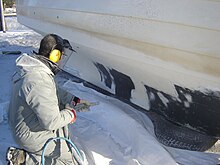Soda jets

The soda blasting is a method of blasting technique in which the surface of a workpiece with sodium hydrogen carbonate is processed ( "bicarbonate") by means of pressure or Injektorstrahltechnik. The sodium hydrogen carbonate used, also known as "food soda", is not identical to the actual soda, the decahydrate of sodium carbonate .
An early use of the technology was in 1986 when cleaning the Statue of Liberty . Since then, the process has found growing applications in other areas such as stripping paint from car bodies, removing graffiti, and cleaning facades and monuments. The actual cleaning effect is created - in contrast to sandblasting with corundum, slag, glass beads, ceramics, thermoset, etc. - not through the sharp-edged or compacting properties, but through the discharge of the surface tension of the individual grain when it hits.
This allows the jet cleaning of almost any surface without measurable removal, wear or damage to the respective surface structure. From 1998, soda blasting found its way into many industrial and craft sectors worldwide, for example for cleaning used engine parts, stripping paint from car bodies, blasting cleaning of listed buildings, graffiti removal, for cleaning mold and extrusion tools, and so on.
Soda blasting - also incorrectly called "baking powder blasting" (soda is only an additive for baking powder ) - is used in both dry and wet blasting processes. By adding a small amount of water to the nozzle, the abrasive has a higher density and is therefore more effective and less dusty.
The process is often confused with dry ice blasting ("ice blasting"), which, however, is fundamentally different from the way it works and how it works.
